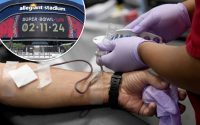Fake Ozempic putting users at risk — how to spot knockoffs
In the mad rush to lose weight, prescriptions for semaglutide drugs like Ozempic, Wegovy and Mounjaro have skyrocketed.
Manufacturers have struggled to keep pace with the overwhelming demand — which has paved the way for compounding pharmacies to step in.
Compounding pharmacies are drugmakers that combine, mix or alter ingredients to create medication that’s tailored to an individual patient.
They might, for example, make a drug for a child who’s allergic to a certain dye and needs a medication without it.
Though they perform an important service, these pharmacies exist in a state of regulatory limbo with lax or conflicting oversight, and their history is riddled with errors — some deadly.
And now, reports are surfacing of Ozempic and other semaglutide drugs made by compounders causing severe or life-threatening overdoses in unsuspecting patients.
“We’ve gotten calls about several of these cases,” Jimmy Leonard, director of clinical services at the Maryland Poison Center at the University of Maryland School of Pharmacy, recently told WebMD. “We’ve had people give themselves tenfold overdoses right off the bat. Boy, were they sick.”

Compounding pharmacy problems
In 2012, a compounding pharmacy in Massachusetts shipped drugs contaminated with a fungus throughout the US — the drugs were injected into patients’ spines and joints.
More than 750 people in 20 states developed severe fungal infections as a result, and 64 people died from the injections.
Drug safety researchers from Pew found 73 compounding errors or potential errors linked to more than 1,562 adverse events, including at least 116 deaths, from 2001 to 2019.
Pew researchers also reported that only 30% of states require compounding pharmacies to report serious adverse events, so the actual tally of deaths and adverse effects is probably much higher.
In most cases, state boards of pharmacy are responsible for the day-to-day oversight of state-licensed pharmacies.
Only compounding pharmacies that register with the Food and Drug Administration as outsourcing facilities under the Federal Food, Drug, and Cosmetic Act are overseen and inspected by the FDA.
And on the occasions that the FDA inspects a compounding pharmacy, it can find very disturbing conditions.
The FDA reports that it “has observed troubling conditions during many of its inspections of compounding facilities, including toaster ovens used for sterilization, pet beds near sterile compounding areas, and operators handling sterile drug products with exposed skin, which sheds particles and bacteria.”

Shortage of semaglutide drugs
The current shortage of semaglutide and many other drugs has been a windfall for compounding pharmacies.
Earlier this year, the University of Utah Drug Information Service reported more than 300 active drug shortages.
Drugs such as Adderall, cancer drugs like carboplatin and cisplatin, anesthetics including lidocaine and ketamine, and antibiotics like amoxicillin are in desperately short supply for hospitals and other medical facilities.
Counterfeit Ozempic
But as compounding pharmacies produce drugs like semaglutide, they’re often dispensing their versions in a liquid vial and an insulin syringe instead of a pen, which makes calculating a proper dosage difficult for patients.
Moreover, the FDA is warning people that the ingredient in compounding pharmacies’ so-called “semaglutide” might not even be semaglutide, but knockoff salt forms such as semaglutide sodium or semaglutide acetate.
These counterfeit salt forms of semaglutide have never been shown to be safe or effective, and the FDA has not tested or approved them for use.
Just last month, the Journal of the American Pharmacists Association reported three cases of semaglutide overdoses, two from compounding pharmacies and one from an aesthetic spa.
Two patients self-administered 10 times the recommended dose, resulting in nausea, vomiting and abdominal pain that lasted for several days.
How to spot fake Ozempic
In June, Ozempic maker Novo Nordisk alerted the public that “a counterfeit Ozempic (semaglutide injection) pen was found in the US.”
The phony product “was reportedly purchased at a retail pharmacy and the company is actively investigating the report and collaborating with the FDA to identify the origin and distribution of the counterfeit pen.”
The drugmaker also offered tips to inform consumers of the differences between the real product and fakes. Genuine Ozempic pens:
- Do not extend or increase in length when setting the dose
- Are available in three doses: 0.25/0.5-milligram pen, 1-milligram pen or 2-milligram pen
- Come in a box that includes four needles that directly attach to the pen, except the 0.25/0.5-milligram dose, which comes with six needles
- Only show the intended dose when dialed up from 0
Genuine Wegovy pens:
- Are available only as fixed-dose auto-injectors and do not have a push button to administer the medication
- There is no option to set a dose or increase the length of the pen. Rather, pens are available in 0.25-milligram, 0.5-milligram, 1-milligram, 1.7-milligram and 2.4-milligram dosages
Counterfeit products can be identified in the following ways:
- The label on a counterfeit pen could be of poor quality and may not adhere well to the pen
- A counterfeit carton may have spelling mistakes or typos on the front of the box
- A counterfeit carton may not include the tamper-resistant perforation
- The batch number printed on a counterfeit box may not correspond to the product strength stated on the same box and pen


